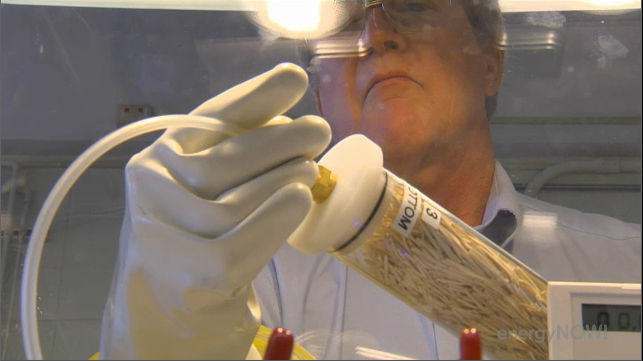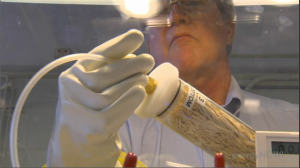Recycling has always meant reusing materials like glass or plastic, and reducing atmospheric carbon has traditionally meant cutting emissions, but what if the two could be combined and make combating climate change profitable by recycling carbon out of the atmosphere?
EnergyNOW! correspondent Josh Zepps looked into a new technology that could pull a thousand times more carbon dioxide out of the atmosphere than trees and could one day power our cars and trucks with green gasoline. The full video is available below:
Most efforts to capture and sequester (CCS) carbon focus on smokestack emissions, but prohibitive costs and unproven technology make this type of carbon reduction unlikely to succeed. In addition, CCS technology can only cut back on new pollution, which fails to address the billions of tons of carbon already in the atmosphere.

These problems need to be solved quickly in order to slow the effects of climate change and move to a clean energy economy. “We know the Earth is getting hotter, the ice caps are starting to melt, the weather patterns are changing,” said Ken Caldeira, an atmospheric scientist with the Carnegie Institution at Stanford University. “This transition to a renewable or carbon neutral energy system could easily take 50 or 100 years, even if we started working on it hard today, which we’re not doing.”
To solve this quandry, two scientists from Columbia University’s Lenfest Center for Sustainable Energy took inspiration from trees and invented a plastic “tree” that absorbs carbon at a much higher rate than Mother Nature.
The idea employs biomimicry by deploying small-scale units of “trees” to soak up more CO2 than real trees, wherever you might need them. “You can remove CO2 anywhere you want, and it can deal with emissions from anywhere else on the planet,” said Allen Wright, a scientist at the Lenfest Center. “There’s no real major discovery or invention that has to happen that would prevent us from deploying that technology tomorrow.”
But beyond just removing CO2 from the atmosphere, the new technology could also turn it into a valuable commodity. Carbon reduction methods often go hand-in-hand with an increase in costs, either through new equipment, or by assessing a fee on emissions. But what if captured carbon could become an economic benefit?
The new technology could serve the existing market for CO2, in enhanced oil recovery, to grow algae for biofuels, in plastic manufacturing, or even in soda – and it could also replace oil-based gasoline. “You can add hydrogen to those (captured) carbon atoms and re-create gasoline,” said Klaus Lackner, a scientist at the Lenfest Center. “It has a zero net impact on the environment because you’re taking the carbon out that burning the gasoline will put in.”
Lackner calls this approach closing the carbon loop because atmospheric carbon can be converted to gasoline, fuel vehicles without drilling for oil, and then collected once again by the “trees.”
But as with all potential energy breakthroughs, it faces two challenges: economics and regulations. The Lenfest researchers expect to be able to sell CO2 to industry for as little as $30 a ton, but they say a tax on carbon dioxide emissions would push up the price of gasoline by about 25 cents a gallon, expand the market for their product, and bring their invention from demonstration to deployment.
Video

 Follow
Follow